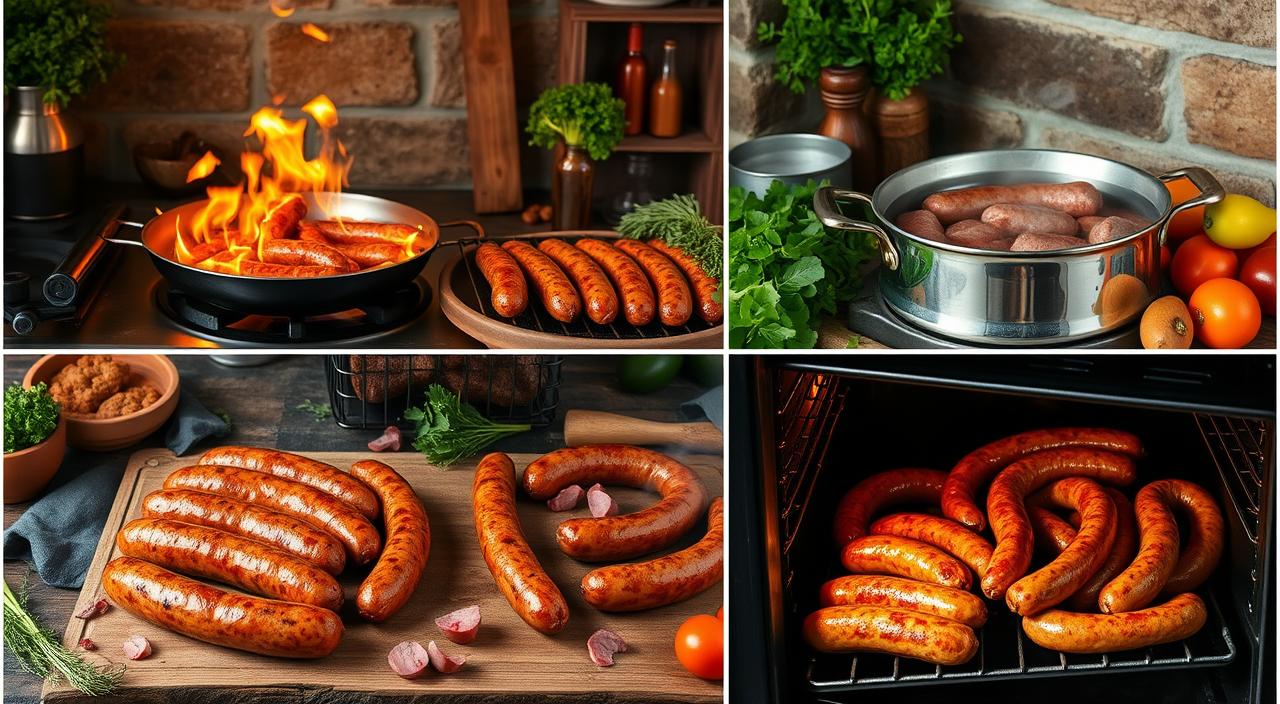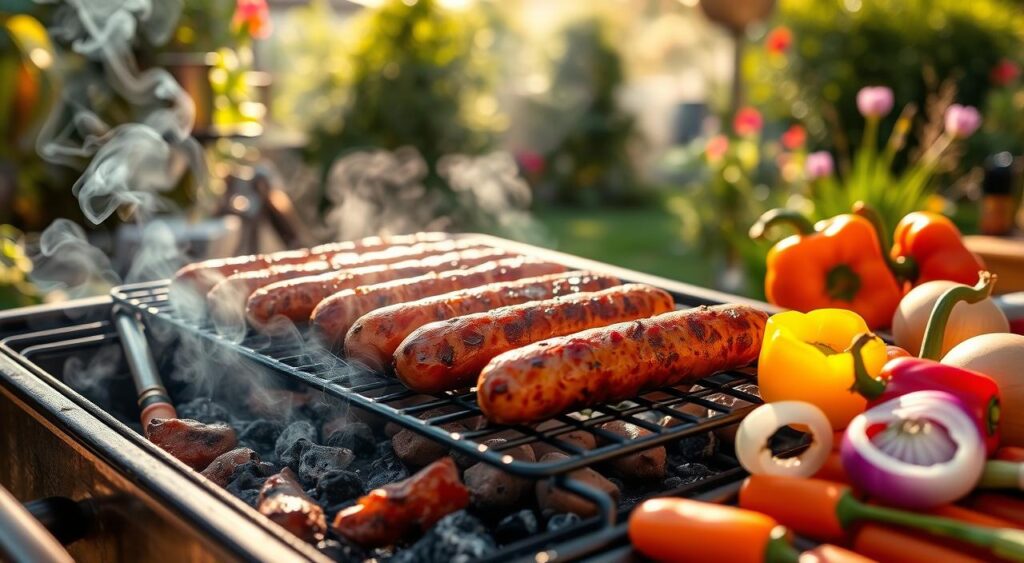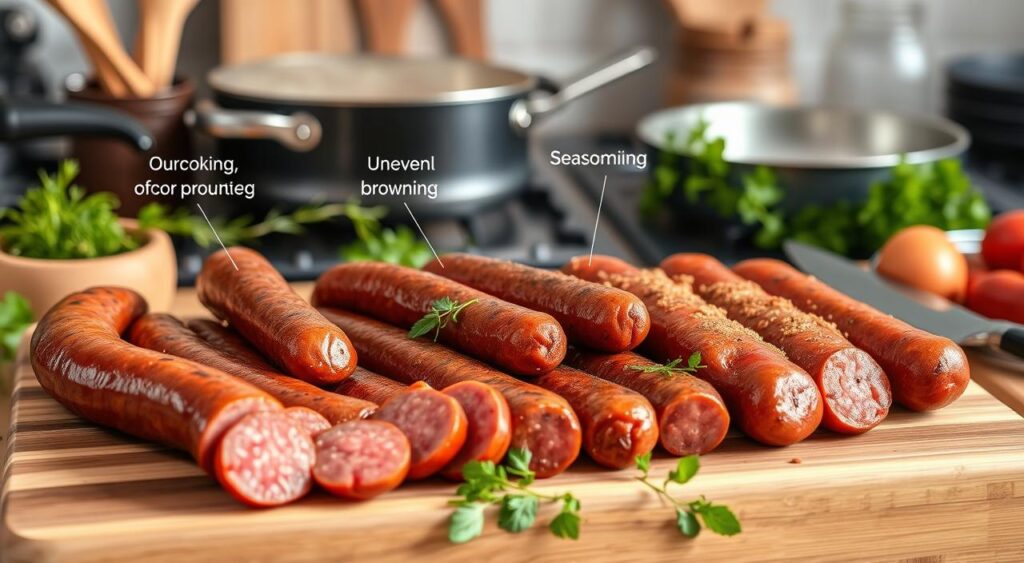Every weekend, the sizzle of beef sausage in my kitchen brings back memories of family cookouts and shared meals. The aroma of perfectly cooked beef sausage can transform an ordinary moment into a culinary adventure that connects us through taste and tradition.
Cooking beef sausage isn’t just about preparing a meal – it’s an art form with multiple techniques that can elevate your cooking skills. Whether you’re a home cook or a culinary enthusiast, understanding the various cooking methods for beef sausage will help you create delicious, restaurant-quality dishes right in your own kitchen.
Different cooking methods like pan-frying, grilling, and oven-baking can dramatically impact the flavor, texture, and overall quality of your beef sausage. Each technique offers unique advantages, allowing you to choose the perfect approach based on your preferences, available equipment, and desired outcome.
Key Takeaways
- Multiple cooking methods exist for beef sausage
- Proper technique ensures juicy and flavorful results
- Cooking times and temperatures vary by method
- Internal temperature is crucial for food safety
- Experimenting with different techniques can enhance flavor
- Equipment and preparation are key to success
- Understanding sausage types impacts cooking approach
Understanding Different Types of Beef Sausage
Beef sausages come in many varieties, changing how we cook and eat. Whether you’re cooking at home or love trying new foods, knowing the difference between raw and pre-cooked sausages is key. It helps you make better choices in the kitchen.
Raw vs Pre-cooked Sausages
Beef sausages are mainly raw or pre-cooked. Raw sausages need to be cooked fully before eating. Pre-cooked sausages just need to be warmed up. Knowing this is important for safety and taste.
- Raw beef sausage: Must reach an internal temperature of 160°F
- Pre-cooked beef sausage: Requires less cooking time
- Fresh sausage typically needs more careful handling
Popular Beef Sausage Varieties
The world of beef sausages is full of flavors. You can find everything from spicy chorizo to traditional German sausages. There’s something for everyone.
- Polish kielbasa
- Hot dogs
- Andouille-style beef sausages
- Spicy Italian beef sausage
Checking for Beef Sausage Quality
Choosing high-quality beef sausage involves a few things. Look for fresh sausage with bright color, firm texture, and no bad smells. Keeping it stored right is also key.
Pro tip: Always check the packaging date and store beef sausages at temperatures between 32°F and 40°F.
Most beef sausages have about 15-17 grams of protein per 3-ounce serving. This makes them a great protein choice for your meals.
Essential Tools and Equipment for Cooking Sausage
Preparing delicious beef sausage needs more than just good meat. The right tools and kitchen equipment can make your cooking better. Having the right tools means you get consistent results and enjoy cooking more.
When you’re setting up your kitchen for sausage, here are the must-haves:
- Heavy-bottomed skillet or cast-iron pan
- Digital meat thermometer
- Kitchen tongs
- Sharp chef’s knife
- Cutting board
Keeping the right temperature is key in sausage cooking. A good meat thermometer ensures the perfect internal temperature, avoiding overcooking or undercooking. Experts say to aim for an internal temperature of 160°F for beef sausages.
“The right kitchen equipment can elevate your sausage from good to gourmet.” – Professional Chef
If you’re serious about sausage making, think about getting more equipment. This includes meat grinders, sausage stuffers, and special cutting tools. While top-notch equipment can cost $1,000 to $2,000, you can start with basics and add more later.
Quality tools make cooking easier and keep your food safe. Keeping your kitchen equipment clean and in good shape means you’ll always have delicious and safe sausage.
Pan-Frying Method for Perfect Beef Sausage
Pan-frying beef sausage is an art that needs precision and skill. The right technique can turn an ordinary sausage into a tasty meal. It should have a crispy casing and rich flavor. Knowing how to control the cooking temperature and heat is key to making great sausages.
When you’re ready to pan-fry beef sausages, picking the right cooking oil is important. A neutral oil with a high smoke point is best for browning sausages. Here are some important steps:
Preparing Your Pan and Oil
- Choose a heavy-bottomed skillet or cast-iron pan
- Use about one tablespoon of cooking oil for sausage
- Choose oils like canola or vegetable oil that can handle high temperatures
Temperature Control Tips
Keeping the right sausage cooking temperature is key for perfect results. Try to keep the heat at a medium-low setting. This ensures even cooking without burning. The ideal internal temperature for beef sausage is between 155-165°F for food safety.
“The secret to perfect pan-fried sausage lies in patience and consistent heat control.”
Achieving the Perfect Crust
- Preheat the pan on medium-low heat
- Add sausages with space between them to prevent crowding
- Cook for 10-12 minutes, turning occasionally
- Look for a golden-brown, crispy exterior
Remember, pan-frying beef sausage needs attention and care. By following these techniques, you’ll make deliciously browned sausages. They will have a satisfying snap and juicy inside.
Grilling Techniques for Flavorful Results
Learning to grill beef sausages can turn a simple meal into a special event. Many grill lovers, about 68%, choose sausages for their quick and tasty nature. This makes them a favorite at backyard barbecues.
Temperature control is key when grilling sausages. Here are some tips to make your grilled beef sausages even better:
- Preheat your grill to medium heat (around 350°F)
- Use indirect heat for more even cooking
- Rotate sausages every 3-4 minutes
- Aim for internal temperature of 160°F
“The secret to perfect grilled sausages is patience and proper heat management.” – Professional Grill Master
Different grills need different methods. Gas grills keep the temperature steady, while charcoal grills add a smoky taste. About 55% of BBQ experts suggest using indirect heat. This helps keep the sausages juicy and prevents burning.
Pro tip: Always use a meat thermometer. It ensures your sausages are cooked to a safe 160°F. This way, you get great taste and keep your food safe.
Oven-Baked Beef Sausage Guide
Cooking sausage in the oven is easy and consistent. It’s a hassle-free way to make delicious beef sausages. You get perfect results with little effort.
Temperature Settings and Timing
Temperature control is key when baking sausage. Here are the important guidelines:
- Preheat the oven to 400°F for most beef sausages
- Cooking time ranges from 15-25 minutes depending on sausage size
- Ensure internal temperature reaches 160°F for beef sausages
Pro tip: Use a meat thermometer to check the internal temperature for perfect doneness.
Using Baking Sheets and Oven Racks
The right baking sheet can greatly improve your results. Here are some tips:
- Use a rimmed baking sheet to catch any drippings
- Place sausages on a wire rack for even air circulation
- Leave space between sausages to promote uniform cooking
For best results, line your baking sheet with parchment paper or use a light coating of cooking spray. This prevents sticking and makes cleanup easier. Convection ovens can provide extra browning and faster cooking times.
Remember, cooking times can vary. This depends on sausage thickness and your oven. Always keep an eye on your sausages. You want that perfect golden-brown exterior and juicy interior.
Boiling and Simmering Methods
Boiling and simmering sausages is great for even cooking and keeping them moist. Boiled beef sausage turns out tender and juicy if done right.
Here are key steps for perfectly simmering sausages:
- Select a wide pan that allows sausages to sit comfortably
- Fill pan with water or broth to cover sausages halfway
- Maintain a gentle simmer, not a rolling boil
- Cook for 10-15 minutes at medium-low heat
When simmering sausages, keep the temperature consistent. Too high heat can cause the casing to split, releasing flavorful juices and potentially creating a less appealing texture.
“The key to perfect boiled beef sausage is patience and careful temperature control.”
Pro tip: After boiling, consider finishing your sausages in a hot skillet for a crispy exterior. This two-step method combines the moisture retention of boiling with the delightful browning from pan-searing.
Always ensure your sausages reach an internal temperature of 160°F for safe consumption. A meat thermometer can help you achieve perfect results every time.
Combining Cooking Methods for Best Results
Mastering the art of cooking beef sausages requires understanding advanced preparation techniques. By combining different cooking methods, you can take your sausage from ordinary to extraordinary. This ensures both great flavor and food safety.
Two-Stage Cooking Process
Parboiling sausages is a game-changing technique that guarantees perfectly cooked meat. This method involves two critical stages:
- Initial poaching to partially cook the sausage
- Finishing techniques that create a crispy exterior
- Maintaining consistent heat throughout the cooking process
“The secret to great sausages is patience and precision in cooking.”
Temperature Monitoring Tips
A meat thermometer is your most reliable tool for achieving the perfect sausage internal temperature. Professional chefs recommend:
- Using an instant-read digital thermometer
- Checking internal temperature without piercing the casing multiple times
- Ensuring the sausage reaches a safe 160°F (71°C)
Pro tip: Let sausages rest for 3-5 minutes after cooking to redistribute juices and maintain optimal flavor and texture.
Common Cooking Mistakes to Avoid
Learning to cook beef sausage well means knowing what mistakes to avoid. These mistakes can turn a tasty meal into a letdown. It’s key to know how to stop sausages from getting overcooked.
There are a few big mistakes that can ruin your sausage cooking:
- Cooking at excessively high temperatures which causes protein contraction
- Piercing the sausage casing unnecessarily
- Failing to monitor internal temperature
- Using a cold pan that causes sticking
Keeping the right temperature is very important. The USDA says to cook sausages to 160°F. Cooking too hot can make the sausages dry and tough.
“Perfect sausage cooking is an art of patience and precision.” – Culinary Expert
To avoid these mistakes, follow these expert tips:
- Use medium-low heat
- Rotate sausages frequently
- Allow sausages to rest after cooking
- Check internal temperature with a meat thermometer
By avoiding these common mistakes, you’ll make sausages that are juicy and full of flavor. Your family and friends will love them.
Serving Suggestions and Pairings
Make your beef sausage recipe special with the right side dishes. These can turn a simple meal into a feast. The perfect side dishes bring out the best in your sausages.
Classic Pairings That Never Disappoint
Traditional side dishes are loved for a reason. They highlight the flavors of beef sausages:
- Creamy mashed potatoes
- Tangy sauerkraut
- Grilled peppers and onions
- Roasted seasonal vegetables
Contemporary Sausage Pairings for Modern Palates
Try new flavors with fusion dishes. These modern pairings offer exciting twists:
- Quinoa salad with roasted vegetables
- Gourmet mustard and chutney combinations
- Mediterranean-inspired grain bowls
- Asian-style stir-fried vegetable medleys
“Great sausages deserve great companions on the plate!” – Chef’s Recommendation
Experiment with both old and new pairings. You’ll find amazing flavor combinations that make every meal unforgettable.
Storage and Reheating Tips
Storing and reheating beef sausage right keeps it tasty and safe to eat. Knowing how to store cooked sausage helps it last longer and stay good.
Here are key tips for storing cooked sausage:
- Refrigerate cooked sausages within two hours of cooking
- Store in airtight containers or sealed plastic bags
- Keep refrigerated at 40°F (4°C) or below
- Consume within 3-4 days for optimal taste and safety
Reheating beef sausage needs care to avoid drying out or overcooking. Here are three ways to do it right:
- Oven method: Preheat to 350°F and heat for 10-15 minutes
- Skillet method: Use medium heat and cook for 6-8 minutes
- Microwave method: Heat in 30-second intervals, checking temperature
Pro tip: Always reheat sausages to an internal temperature of 165°F (74°C) to ensure food safety.
Freezing is great for long-term storage. Cooked sausages can be frozen for up to two to three months. Wrap them tightly in freezer-safe packaging to prevent freezer burn and maintain quality.
Always check for signs of spoilage before eating stored sausages. Look for unusual odors, discoloration, or changes in texture.
Health and Safety Considerations
Understanding how to cook sausages safely is key to keeping your family healthy. Foodborne illnesses affect millions in the U.S. each year. So, it’s important to handle sausages correctly.
Safe Internal Temperature Guidelines
Cooking sausages to the right temperature is the first step in food safety. Different sausages need different temperatures to kill harmful bacteria:
- Ground beef sausages: Cook to 160°F
- Ground poultry sausages: Cook to 165°F
- Fresh sausages: Cook within 2 days of purchase
“Cooking meat to the proper internal temperature is your best defense against foodborne illness.” – USDA Food Safety Guidelines
Food Handling Best Practices
Food safety is more than just cooking. Here are some key tips for handling sausages:
- Wash hands thoroughly before and after handling raw meat
- Use separate cutting boards for raw meats
- Clean all surfaces and utensils after preparation
- Refrigerate sausages promptly
- Never thaw sausages at room temperature
By following these tips, you can lower the risk of contamination. This ensures a safe and tasty meal for your family.
Conclusion
Making the perfect beef sausage is more than just cooking. It’s about knowing different methods, picking the best ingredients, and trying new flavors. It’s all about precision, passion, and what you like best.
Try out different ways to cook your sausage. You might like pan-frying, grilling, or baking in the oven. Each method can give you a unique taste and texture. Both pros and home cooks know it takes practice to get it right.
Remember, safety and quality are key when cooking sausage. Use a meat thermometer to check the temperature. Choose sausages from places that care about the animals and the environment. There’s a big world of gourmet sausages out there, waiting to be explored.
Start your journey to sausage mastery with knowledge, creativity, and a love for good food. Dive into the world of sausage cooking and make every meal special.
FAQ
What’s the difference between raw and pre-cooked beef sausages?
Raw sausages need to be fully cooked to a safe temperature. Pre-cooked sausages just need to be warmed up. Raw sausages have a shorter shelf life and need more care to avoid food safety issues. Pre-cooked sausages are quicker to serve and more convenient.
How do I know if a beef sausage is fresh?
Look for a bright color, firm texture, and no odd smells. Check the packaging date and make sure it’s not damaged. Fresh sausages should look clean and smell like meat, not slimy or bad.
What’s the safest internal temperature for beef sausages?
Beef sausages should be cooked to 160°F (71°C). Use a meat thermometer to check the thickest part. This ensures they’re safe to eat without being too dry.
Can I cook beef sausages from frozen?
You can cook sausages from frozen, but thawing first is better. If frozen, cook longer and check the temperature reaches 160°F. Thawing in the fridge is safest to avoid bacteria.
What are the best cooking methods for beef sausages?
Pan-frying, grilling, oven-baking, and boiling are great methods. Pan-frying gives a crispy outside, grilling adds smoky taste, oven-baking cooks evenly, and boiling keeps moist. Choose based on what you like and what you have.
How long should I cook beef sausages?
Cooking time varies by method and type. Pan-frying takes 10-15 minutes, grilling 12-15 minutes, oven-baking 20-25 minutes, and boiling 10-12 minutes. Always check the temperature with a meat thermometer to ensure it’s 160°F.
How can I prevent sausages from splitting while cooking?
Cook over medium-low heat, turn gently, and don’t pierce the casing. Use tongs instead of forks and avoid high heat. For grilling, use indirect heat and rotate often for even cooking.
What are the best side dishes for beef sausages?
Try sauerkraut, mashed potatoes, grilled peppers and onions, and potato salad. For something new, try quinoa salads, roasted veggies, or grain bowls. The goal is to balance the sausage’s flavor with good sides.
How long can I store cooked beef sausages?
Cooked sausages can be refrigerated for 3-4 days in an airtight container. Freeze for up to 2-3 months for longer storage. Cool them down before storing and reheat to 165°F before eating.
Can I reheat beef sausages?
Yes, you can reheat sausages in an oven, microwave, or on the stovetop. Oven reheating (around 350°F for 10-15 minutes) is best for even heating. Avoid overheating to keep them moist. Always check the temperature reaches 165°F for safety.



